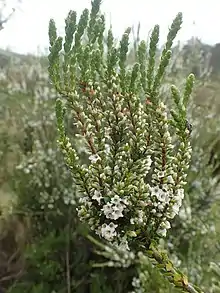Epacris rhombifolia
Epacris rhombifolia commonly known as mountain coral heath,[3] is a plant in the heath family Ericaceae and is endemic to eastern Australia. It is an erect, multi-stemmed shrub with broad, rhombic leaves and white flowers with four petals, the flowers spreading down the branches. It only grows in wet, subalpine heath and is sometimes regarded as a variety of Epacris microphylla.
| Mountain coral heath | |
|---|---|
 | |
| Epacris rhombifolia in Barrington Tops National Park | |
| Scientific classification | |
| Kingdom: | Plantae |
| Clade: | Tracheophytes |
| Clade: | Angiosperms |
| Clade: | Eudicots |
| Clade: | Asterids |
| Order: | Ericales |
| Family: | Ericaceae |
| Genus: | Epacris |
| Species: | E. rhombifolia |
| Binomial name | |
| Epacris rhombifolia | |
| Synonyms[2] | |
| |
Description
Epacris rhombifolia is an erect shrub with several main stems and which grows to a height of 2 metres (7 ft). The young stems are reddish-brown and covered with short, soft, downy hairs when young. The leaves are rhombic, 2.0–4.5 mm (0.08–0.2 in) long and 1.5–3.5 mm (0.06–0.1 in) wide, more or less flat and overlap each other when young. They are glabrous, have indistinct veins and a petiole 0.3–0.8 mm (0.01–0.03 in) long. The flowers are white, 3.8–5 mm (0.1–0.2 in) wide and arranged in leaf axils, spreading down the branches and have white petals forming a bell-shaped tube. The buds are surrounded by 16-20 white, egg-shaped bracts and white, egg-shaped sepals 1.5–2.5 mm (0.06–0.1 in) long and longer than the petal tube. The petal tube is about 1 mm (0.04 in) long, 1.5–2 mm (0.06–0.08 in) wide and the lobes are about 1.7 mm (0.07 in) long and do not overlap. Flowering occurs from December to March and the fruit that follows are capsules about 2 mm (0.08 in) long and wide.[1][4][5]
Taxonomy and naming
Mountain coral heath was first formally described in 1810 by Lilian Fraser and Joyce Vickery, who gave it the name Epacris microphylla var. rhombifolia. The description was published in Journal and Proceedings of the Linnean Society of New South Wales.[2][6] The variety was raised to species level in 2015 by Yvonne Menadue and Ron Crowden.[7] The specific epithet (rhombifolia) is derived from the Latin words rhombus meaning "an equilateral parallelogram with unequal pairs of angles"[8]:263 and folium meaning "leaf".[8]:466
Distribution and habitat
Epacris rhombifolia grows in wet heath in subalpine areas of Lake Mountain, Mount Baw Baw and the ranges north of Licola in Victoria and in the Barrington Tops, Wingello and Oberon districts of New South Wales.[1][4][5]
Use in horticulture
Mountain coral heath has horticultural merit with its display of dainty flowers. It is suitable for a small, permanently moist, sheltered garden and can be grown in containers.[3]
 Epacris rhombifolia at Polblue Swamp, Barrington Tops National Park
Epacris rhombifolia at Polblue Swamp, Barrington Tops National Park Epacris rhombifolia habit at Polblue Swamp, Barrington Tops National Park
Epacris rhombifolia habit at Polblue Swamp, Barrington Tops National Park Close-up of flowers, Epacris rhombifolia
Close-up of flowers, Epacris rhombifolia Mature foliage of Epacris rhombifolia
Mature foliage of Epacris rhombifolia
References
- Brown, E. (1990). "Epacris rhombifolia (L.R.Fraser & Vickery) Crowden". Plantnet - New South Wales Flora Online. Royal Botanic Gardens, Sydney. Retrieved 11 September 2015.
- "Epacris microphylla var. rhombifolia". APNI. Retrieved 26 December 2017.
- "Epacris microphylla var. rhombifolia". Yarra Ranges Shire Council. Retrieved 26 December 2017.
- Walsh, Neville. "Epacris rhombifolia". Royal Botanic Gardens Victoria. Retrieved 26 December 2017.
- Menadue, Yvonne; Crowden, Ron (18 November 2015). "Change of status for Epacris microphylla R.Br. var. rhombifolia L.R.Fraser & Vickery (Ericaceae: Epacridoideae)". Telopea. 18: 451–453. doi:10.7751/telopea9149. Retrieved 26 December 2017.
- Fraser, Lilian R.; Vickery, Joyce W. (1937). "Notes on species in upper Williams River and Barrington Tops districts". Journal and Proceedings of the Linnean Society of New South Wales. 62: 290–291. Retrieved 26 December 2017.
- "Epacris rhombifolia". APNI. Retrieved 26 December 2016.
- Brown, Roland Wilbur (1956). The Composition of Scientific Words. Washington, D.C.: Smithsonian Institution Press.